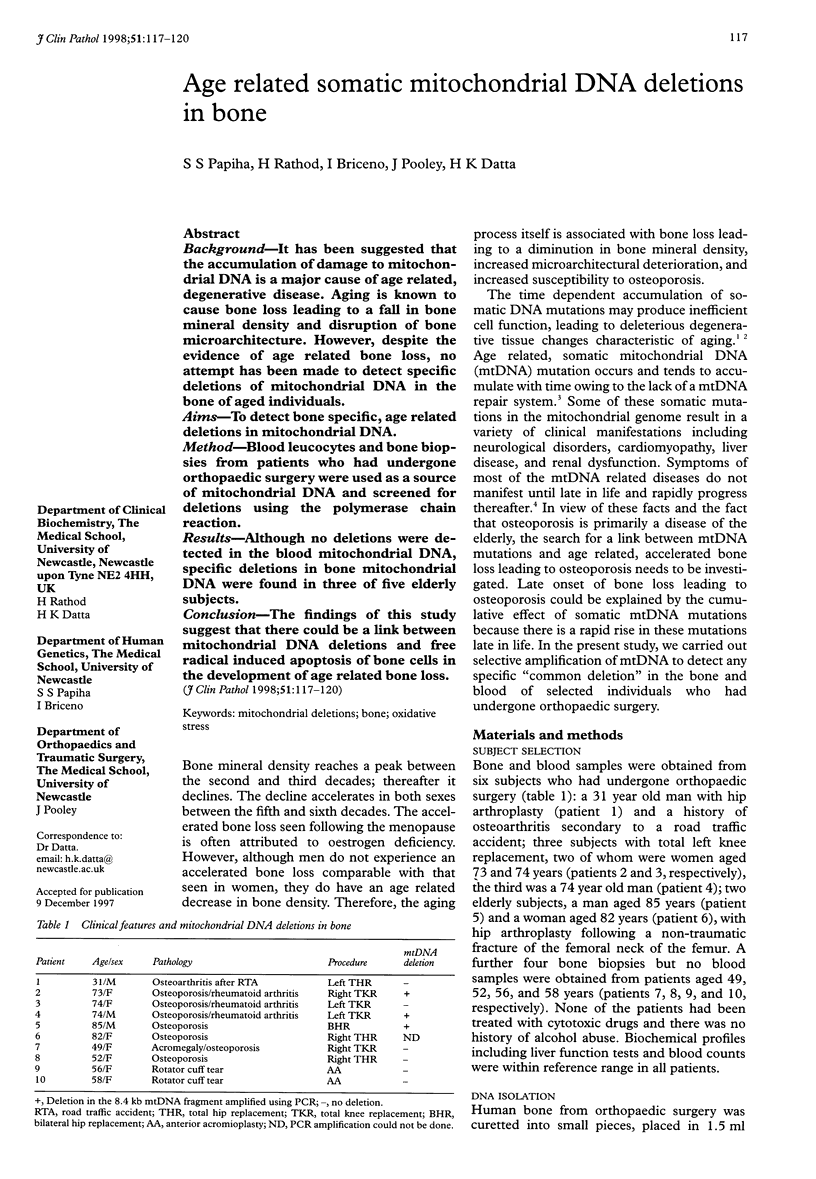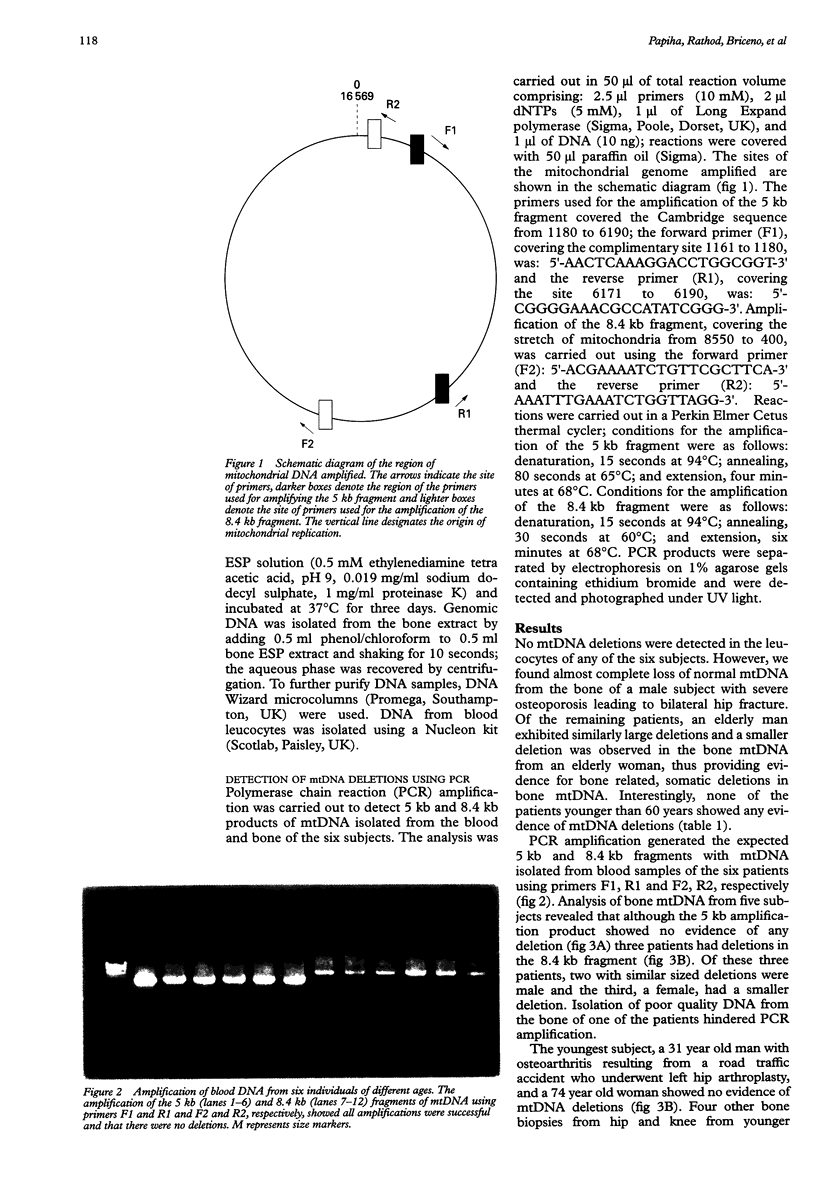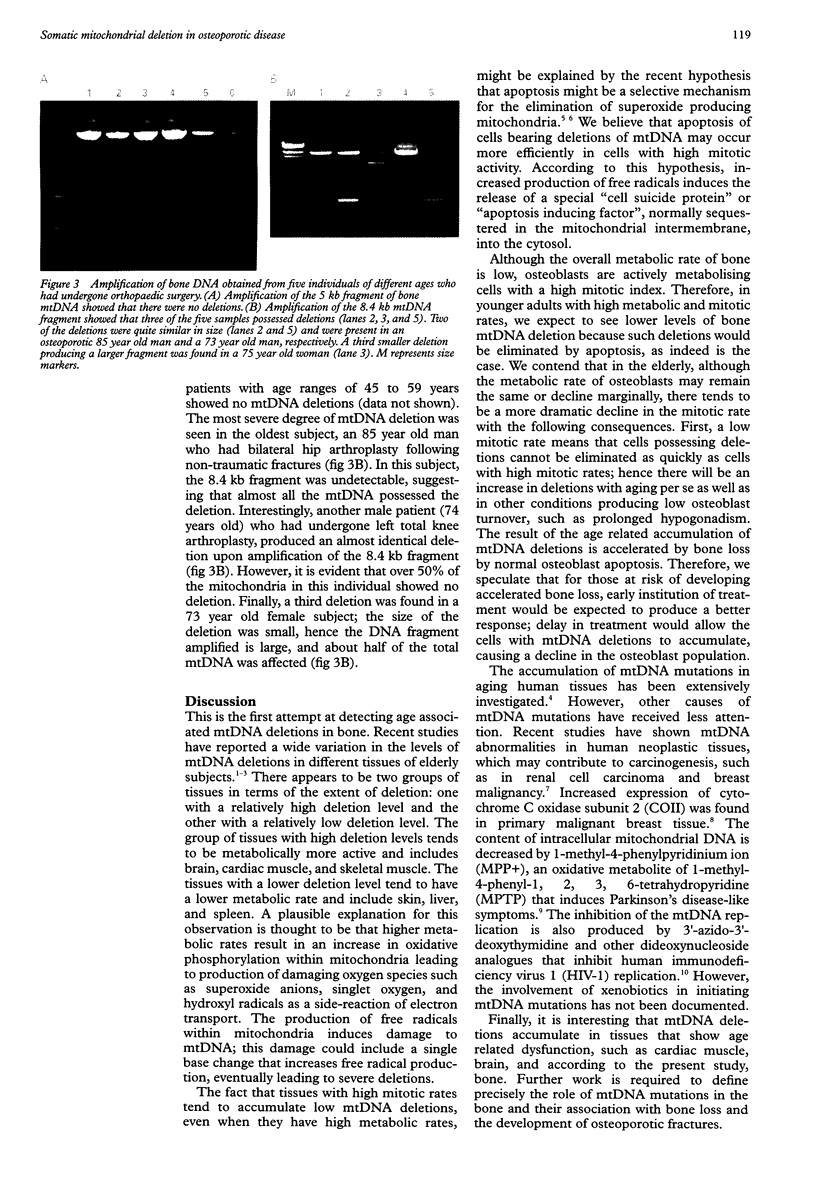Abstract
BACKGROUND: It has been suggested that the accumulation of damage to mitochondrial DNA is a major cause of age related, degenerative disease. Aging is known to cause bone loss leading to a fall in bone mineral density and disruption of bone microarchitecture. However, despite the evidence of age related bone loss, no attempt has been made to detect specific deletions of mitochondrial DNA in the bone of aged individuals. AIMS: To detect bone specific, age related deletions in mitochondrial DNA. METHOD: Blood leucocytes and bone biopsies from patients who had undergone orthopaedic surgery were used as a source of mitochondrial DNA and screened for deletions using the polymerase chain reaction. RESULTS: Although no deletions were detected in the blood mitochondrial DNA, specific deletions in bone mitochondrial DNA were found in three of five elderly subjects. CONCLUSION: The findings of this study suggest that there could be a link between mitochondrial DNA deletions and free radical induced apoptosis of bone cells in the development of age related bone loss.
Full text
PDF



Images in this article
Selected References
These references are in PubMed. This may not be the complete list of references from this article.
- Cortopassi G. A., Shibata D., Soong N. W., Arnheim N. A pattern of accumulation of a somatic deletion of mitochondrial DNA in aging human tissues. Proc Natl Acad Sci U S A. 1992 Aug 15;89(16):7370–7374. doi: 10.1073/pnas.89.16.7370. [DOI] [PMC free article] [PubMed] [Google Scholar]
- Holt I. J., Harding A. E., Morgan-Hughes J. A. Deletions of muscle mitochondrial DNA in patients with mitochondrial myopathies. Nature. 1988 Feb 25;331(6158):717–719. doi: 10.1038/331717a0. [DOI] [PubMed] [Google Scholar]
- Horton T. M., Petros J. A., Heddi A., Shoffner J., Kaufman A. E., Graham S. D., Jr, Gramlich T., Wallace D. C. Novel mitochondrial DNA deletion found in a renal cell carcinoma. Genes Chromosomes Cancer. 1996 Feb;15(2):95–101. doi: 10.1002/(SICI)1098-2264(199602)15:2<95::AID-GCC3>3.0.CO;2-Z. [DOI] [PubMed] [Google Scholar]
- Miyako K., Kai Y., Irie T., Takeshige K., Kang D. The content of intracellular mitochondrial DNA is decreased by 1-methyl-4-phenylpyridinium ion (MPP+). J Biol Chem. 1997 Apr 11;272(15):9605–9608. doi: 10.1074/jbc.272.15.9605. [DOI] [PubMed] [Google Scholar]
- Petit P. X., Susin S. A., Zamzami N., Mignotte B., Kroemer G. Mitochondria and programmed cell death: back to the future. FEBS Lett. 1996 Oct 28;396(1):7–13. doi: 10.1016/0014-5793(96)00988-x. [DOI] [PubMed] [Google Scholar]
- Sharp M. G., Adams S. M., Walker R. A., Brammar W. J., Varley J. M. Differential expression of the mitochondrial gene cytochrome oxidase II in benign and malignant breast tissue. J Pathol. 1992 Oct;168(2):163–168. doi: 10.1002/path.1711680203. [DOI] [PubMed] [Google Scholar]
- Simonetti S., Chen X., DiMauro S., Schon E. A. Accumulation of deletions in human mitochondrial DNA during normal aging: analysis by quantitative PCR. Biochim Biophys Acta. 1992 Dec 10;1180(2):113–122. doi: 10.1016/0925-4439(92)90059-v. [DOI] [PubMed] [Google Scholar]
- Simpson M. V., Chin C. D., Keilbaugh S. A., Lin T. S., Prusoff W. H. Studies on the inhibition of mitochondrial DNA replication by 3'-azido-3'-deoxythymidine and other dideoxynucleoside analogs which inhibit HIV-1 replication. Biochem Pharmacol. 1989 Apr 1;38(7):1033–1036. doi: 10.1016/0006-2952(89)90245-1. [DOI] [PubMed] [Google Scholar]
- Skulachev V. P. Why are mitochondria involved in apoptosis? Permeability transition pores and apoptosis as selective mechanisms to eliminate superoxide-producing mitochondria and cell. FEBS Lett. 1996 Nov 11;397(1):7–10. doi: 10.1016/0014-5793(96)00989-1. [DOI] [PubMed] [Google Scholar]
- Wallace D. C. Mitochondrial genetics: a paradigm for aging and degenerative diseases? Science. 1992 May 1;256(5057):628–632. doi: 10.1126/science.1533953. [DOI] [PubMed] [Google Scholar]




